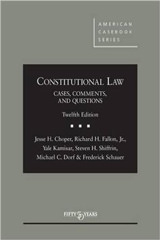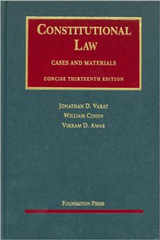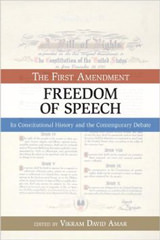The new Trump administration has done many things that violate the Constitution. Think barring lawyers from entering public buildings simply for having represented Democrats or other political critics of the President and his team. Think demanding (on pain of financial penalty) that a private university hire and admit faculty and students of particular political ideologies. Think denying citizenship to persons born in the United States whose parents were present legally if only for a limited duration.
And the administration and its congressional allies have also wrongly threatened impeachment and engaged in other acts of bullying against judges, such as federal district judge James Boasberg, whose substantive rulings seek to insist that the limits in the Constitution and applicable congressional statutes—including limits grounded in due process access to judicial redress—are fully respected. While I (unlike some others) personally do not think the President has up to this point defied a clear, defensible, and explicit command from the Supreme Court (and I predict if that were to happen in a domestic realm where the Court was on firm constitutional ground, the financial markets—and thus popular support for the President—would plummet), I do acknowledge the administration may not be operating in good faith in its interactions with lower federal court judges in several cases.
It is probably largely for these reasons that the media (and some talking-head commentators) have been so quick to lump last week’s arrest by the administration of Wisconsin state court judge Hannah Dugan, for interfering with ICE’s efforts to arrest and deport a person present in the United States unlawfully, into this pattern of assault upon the judiciary in an effort to undermine and subdue an important organ of government that might stand in the way of unbridled federal executive power. A commentator’s remarks in the Washington Post were representative in this respect, in describing Dugan’s arrest as “an attempt to bludgeon, an attempt to coerce, an attempt to weaken the one branch of government that stands between the executive—the Trump administration—and it doing whatever it wishes to do.”
But this characterization is misplaced, and it reflects a failure to draw distinctions that careful lawyering and adherence to true rule-of-law principles require. To see this, we need begin with the federal government’s formal accusations (drawn from the U.S. Department of Justice website) against Judge Dugan:
The Justice Department today [April 25] announced the filing of a federal criminal complaint against Milwaukee County Circuit Court Judge Hannah C. Dugan, 65, for her alleged interference with a federal law enforcement operation and unlawful concealment of an individual subject to arrest.
According to court documents, the charges stem from events occurring on April 18, when members of the Milwaukee office of U.S. Immigration and Customs Enforcement, Enforcement and Removal Operations (ICE ERO), along with federal partners from the FBI, DEA, and U.S. Customs and Border Protection, attempted to execute a lawful arrest warrant for Eduardo Flores-Ruiz, a Mexican national previously removed from the United States and recently charged in Milwaukee County with multiple counts of domestic abuse-related battery. [Flores-Ruiz was previously deported in 2013 and had reentered the United States unlawfully. He was subject to arrest based on an administrative warrant issued by ICE for immigration violations following his recent criminal charges in Milwaukee County.]
According to court documents, federal agents arrived at the Milwaukee County Courthouse intending to arrest Flores-Ruiz in a public hallway following his court appearance before Judge Dugan. Upon learning of the agents’ presence in the hallway, Judge Dugan allegedly confronted and ordered federal agents to leave the courthouse. After being made aware of a valid immigration arrest warrant, Judge Dugan told agents that they needed a judicial warrant and demanded that they go to the Chief Judge’s office. Once the agents were no longer in the vicinity of her courtroom, Judge Dugan allegedly elected not to conduct a hearing on Flores-Ruiz’s criminal case, despite the fact that victims of his offense were present, and instead personally escorted Flores-Ruiz and his attorney through a restricted “jury door” exit not typically used by defendants or attorneys. This doorway led to a non-public hallway through which Flores-Ruiz and his attorney exited her courtroom. According to the affidavit, Judge Dugan’s actions directly resulted in Flores-Ruiz temporarily avoiding federal custody. He was ultimately arrested outside the courthouse, following a brief foot pursuit.
Dugan is charged with obstruction of proceedings before a department or agency of the United States, which carries a maximum penalty of five years in prison and concealing a person to prevent arrest, which carries a maximum penalty of one year in prison.
Taking these allegations as true (and at this point I don’t know how anyone could assess the episode except by reference to the allegations made, even if the evidence in the case ultimately proves different facts), not only is Judge Dugan’s arrest completely different from the impeachment threats against Judge Boasberg, her arrest is fully in keeping with—rather than contrary to—constitutional and rule-of-law first principles.
The Dugan-arrest episode is completely different from the Boasberg attacks because, although they both involve threats of coercive action (incarceration for Dugan and impeachment for Boasberg), in Boasberg’s case the threats came in response to legal rulings by Judge Boasberg that the administration finds erroneous, unfair or inconvenient. But threatening federal judges because of the outcomes they reach in resolving cases runs afoul of judicial independence and compromises separation of powers, one of the two most important structural themes running through the Constitution. By contrast, the arrest in Dugan’s case came (according to the allegations) not in response to a ruling Dugan rendered in her capacity as a judge deciding cases, but instead in response to something she did in her capacity as an individual aider and abettor of someone who was trying to elude federal authorities. Dugan’s arrest thus does not run afoul of the independence that all judges enjoy (and should enjoy), under separation of power, to make legal rulings consistent with the good-faith legal views of the judges, and indeed vindicates the other of the two most important structural themes in the Constitution—the principle of federalism, under which duly enacted and otherwise valid federal law is supreme over inconsistent state laws and policies, and under which all persons, including state officers, must comply with valid federal enactments.
Although some states (and cities) might style themselves as “sanctuary” jurisdictions, states (while not obligated under current Supreme Court doctrine to assist federal enforcement officials) and their employees have no right to obstruct or interfere with enforcement by federal agents. As I wrote at the beginning of the first Trump administration in 2017 (almost literally eight years ago to the day), California’s Supreme Court Chief Justice at the time, Tani Cantil-Sakauye, wrote a letter to federal authorities complaining of what she saw as federal agents’ “stalking” of state courthouses to apprehend individuals in the U.S. in violation of immigration laws. As I observed at the time, although Chief Justice Cantil-Sakauye was well within her rights (and acting well within the tradition of the political safeguards of federalism) to publicly complain about what she saw as federal excess, if state court marshals (or judges) were to interfere with or try to block federal officials in public areas in and around state courthouse facilities, such action by state officials would not be protected, and indeed would conflict with the Constitution’s command that federal law (and enforcement of permissible federal enactments) be supreme and respected by all state officials.
In other words, as I explained, although the decision of sanctuary jurisdictions to decline to lend certain kinds of enforcement assistance to federal immigration authorities may very well be protected by the so-called anti-commandeering principle reflected in New York v. United States and Printz v. United States,
even under the broadest readings of New York and Printz, state and local authorities have no right to interfere with federal immigration enforcement, say, by harboring individuals sought by federal authorities, impeding access to such individuals by federal officials, or providing false information to the feds.
So if Judge Dugan did what she is alleged to have done, she would not appear to have much legal ground to stand on. (Imagine a state judge in the deep South in the 1960s similarly abetting the attempted escape of someone the feds sought to arrest in connection with bombings of black churches.) And criticizing and punishing judges for violating valid (if controversial) federal law is entirely different from criticizing and punishing judges for issuing judicial rulings one does not like. (In this regard, state court rulings on federal law can be reversed by the Supreme Court, but that is a far cry from arresting or otherwise punishing judges for their legal decisions.)
Indeed, most critics of President Trump (rightly) bemoan the U.S. Supreme Court decision last year in Trump v. United States that immunizes presidents from criminal liability for virtually (if not literally) all actions undertaken while on the job. But if presidents should not be above the law, as most Americans and legal analysts believe, a fortiori neither should state court judges.









